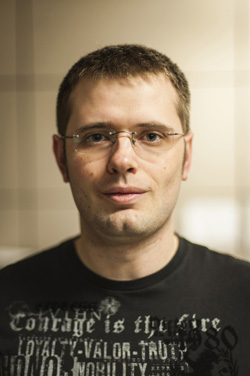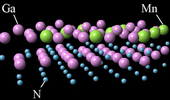By Jessica Salerno
Office of Research Communications
Few physics students can say that they helped analyze a first-of-its-kind molecular motor, published a research article in the prestigious journal Nature Nanotechnology, and helped the U.S. Department of Energy’s Argonne National Laboratory to construct a major new piece of scientific equipment all in one year.
But those are exactly the achievements you’ll find Ohio University graduate student Heath Kersell adding to his resume.
Kersell, a doctoral candidate in Physics and Astronomy, is a student of condensed matter physics, which is the study of the properties of materials. He was attracted to the area because of its applications to everyday life.
“I think that the knowledge gained from physics research is sometimes used to make extremely useful advances in technology. And I like that the research that I do could one day be applied to actually make people’s lives better,” he says.
Kersell, who works with Dr. Saw-Wai Hla, Professor of Physics, studies the development of machines at the nanoscale, where matter behaves in unexpected ways.
“Just like other machines, they need some sort of energy to operate,” he says. “My research focuses on a type of molecular rotor that’s a candidate for not only a source of energy inputs for nanoscale machines, but also as a potential component for other more complicated devices under development at the molecular scale.”
In December, Kersell, Hla, and an international team of researchers revealed images of the molecular motor, which can rotate clockwise and counterclockwise. It’s the first time nanoscientists have designed and been able to control the movements of such a complex device.
In April, Kersell won the 2012 Distinguished Master’s Thesis Award from the Midwestern Association of Graduate Schools for his contributions to the project. He’s Ohio University’s first recipient of the award in more than a decade.
Working in the Hla lab not only led to interesting new findings in nanotechnology, but also helped Kersell gain experience with the scanning tunneling microscopy equipment necessary to carry out the experiments. This type of microscope helps to image individual molecules.
That experience led Kersell to his current internship at Argonne, located just outside of Chicago, where he is building a new scanning tunneling microscope.
“The opportunity to build an entire STM system, especially one having additional capabilities like laser access for the microscope, is relatively rare for students,” he says.
Kersell hopes that his work could one day help scientists grappling with how to make smaller but effective electronic devices for industry. Kersell is a student in the Department of Physics and Astronomy in the College of Arts and Sciences.
This article appears in the special graduate student edition of Perspectives magazine, published in spring 2013.everyday life.




















Comments